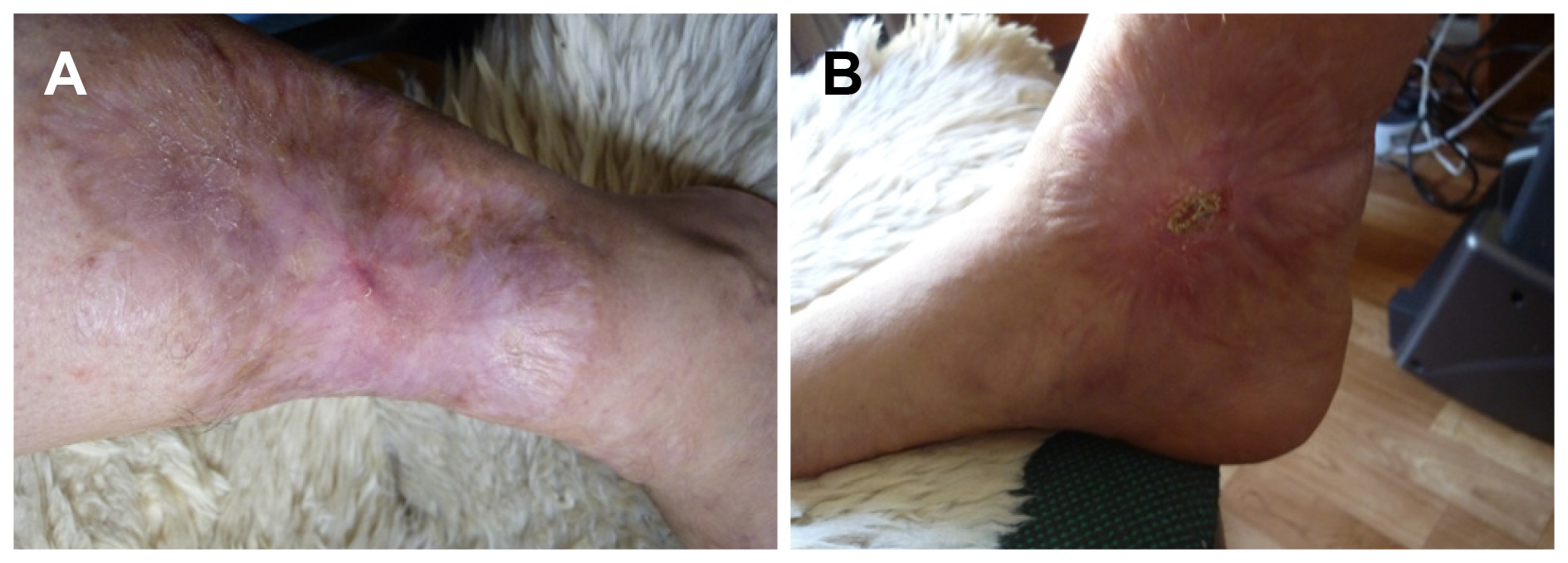Korean J Gastroenterol.
2020 Apr;75(4):225-227. 10.4166/kjg.2020.75.4.225.
Pyoderma Gangrenosum in a Patient with Inactive Ulcerative Colitis
- Affiliations
-
- 1Division of Gastroenterology, Department of Internal Medicine, Kyung Hee University Hospital at Gangdong, Kyung Hee University School of Medicine, Seoul, Korea
- KMID: 2504241
- DOI: http://doi.org/10.4166/kjg.2020.75.4.225
Figure
Reference
-
1. Bernstein CN, Blanchard JF, Rawsthorne P, Yu N. 2001; The prevalence of extraintestinal diseases in inflammatory bowel disease: a population-based study. Am J Gastroenterol. 96:1116–1122. DOI: 10.1111/j.1572-0241.2001.03756.x. PMID: 11316157.
Article2. Ricart E, Panaccione R, Loftus EV Jr, et al. 2004; Autoimmune disorders and extraintestinal manifestations in first-degree familial and sporadic inflammatory bowel disease: a case-control study. Inflamm Bowel Dis. 10:207–214. DOI: 10.1097/00054725-200405000-00005. PMID: 15290913.3. Farhi D, Cosnes J, Zizi N, et al. 2008; Significance of erythema nodosum and pyoderma gangrenosum in inflammatory bowel diseases: a cohort study of 2402 patients. Medicine (Baltimore). 87:281–293. DOI: 10.1097/MD.0b013e318187cc9c. PMID: 18794711.4. Brooklyn T, Dunnill G, Probert C. 2006; Diagnosis and treatment of pyoderma gangrenosum. BMJ. 333:181–184. DOI: 10.1136/bmj.333.7560.181. PMID: 16858047. PMCID: PMC1513476.
Article5. Ruocco E, Sangiuliano S, Gravina AG, Miranda A, Nicoletti G. 2009; Pyoderma gangrenosum: an updated review. J Eur Acad Dermatol Venereol. 23:1008–1017. DOI: 10.1111/j.1468-3083.2009.03199.x. PMID: 19470075.
Article6. Braswell SF, Kostopoulos TC, Ortega-Loayza AG. 2015; Pathophysiology of pyoderma gangrenosum (PG): an updated review. J Am Acad Dermatol. 73:691–698. DOI: 10.1016/j.jaad.2015.06.021. PMID: 26253362.
Article7. Adachi Y, Kindzelskii AL, Cookingham G, et al. 1998; Aberrant neutrophil trafficking and metabolic oscillations in severe pyoderma gangrenosum. J Invest Dermatol. 111:259–268. DOI: 10.1046/j.1523-1747.1998.00311.x. PMID: 9699727.
Article8. Ahronowitz I, Harp J, Shinkai K. 2012; Etiology and management of pyoderma gangrenosum: a comprehensive review. Am J Clin Dermatol. 13:191–211. DOI: 10.2165/11595240-000000000-00000. PMID: 22356259.9. Ehling A, Karrer S, Klebl F, Schäffler A, Müller-Ladner U. 2004; Therapeutic management of pyoderma gangrenosum. Arthritis Rheum. 50:3076–3084. DOI: 10.1002/art.20559. PMID: 15476233.
Article10. Barrie A, Regueiro M. 2007; Biologic therapy in the management of extraintestinal manifestations of inflammatory bowel disease. Inflamm Bowel Dis. 13:1424–1429. DOI: 10.1002/ibd.20196. PMID: 17567879.
Article11. Duffill MB. 1994; Cyclosporine, azathioprine and local therapy for pyoderma gangrenosum. Australas J Dermatol. 35:15–18. DOI: 10.1111/j.1440-0960.1994.tb01793.x. PMID: 7998894.
Article12. Nielsen OH, Vainer B, Rask-Madsen J. 2001; Review article: the treatment of inflammatory bowel disease with 6-mercaptopurine or azathioprine. Aliment Pharmacol Ther. 15:1699–1708. DOI: 10.1046/j.1365-2036.2001.01102.x. PMID: 11683683.13. Sardar P, Guha P, Das NK, et al. 2011; Ulcerative pyoderma gangrenosum in mixed connective tissue disorder: a rare association and role of azathioprine in the management. Indian J Dermatol. 56:600–602. DOI: 10.4103/0019-5154.87172. PMID: 22121294. PMCID: PMC3221239.
Article14. Tusnádi A, Uhrin K, Bényei M, Krasznai G. 1994; Ulcerative colitis associated with pyoderma gangrenosum. Orv Hetil. 135:917–919. PMID: 7909938.
- Full Text Links
- Actions
-
Cited
- CITED
-
- Close
- Share
- Similar articles
-
- A Case of Post-traumatic Pyoderma Gangrenosum Associated with Ulcerative Colitis
- A Case of Pyoderma Gangrenosum Associated with Ulcerative Colitis
- Multiple Pyoderma Gangrenosum in Ulcerative Colitis
- A Case of Simultaneous Presentation of Bullous and Ulcerative Types of Pyoderma Gangrenosum in an Ulcerative Colitis Patient
- Pyoderma Gangrenosum in a Patient with Ulcerative Colitis: A Case Report




